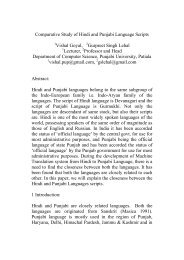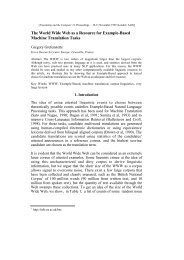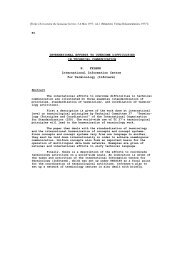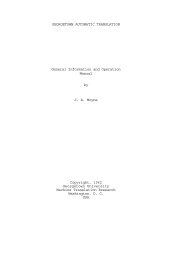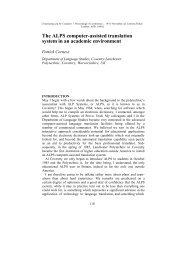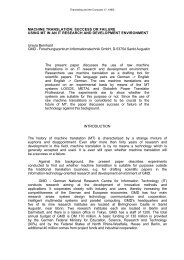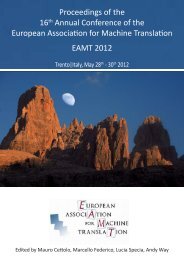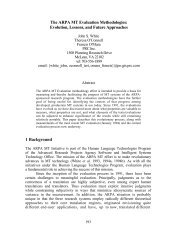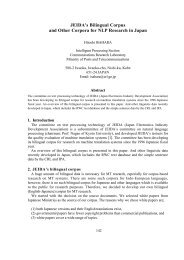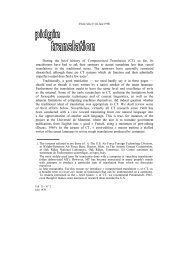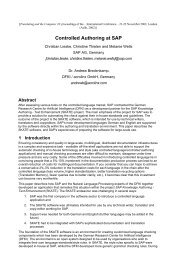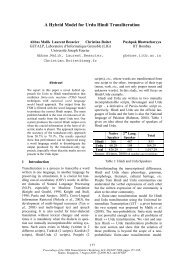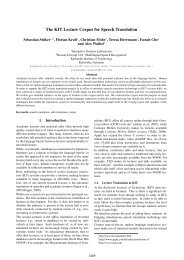Machine translation with inferred finite-state transducers
Machine translation with inferred finite-state transducers
Machine translation with inferred finite-state transducers
You also want an ePaper? Increase the reach of your titles
YUMPU automatically turns print PDFs into web optimized ePapers that Google loves.
Computational Linguistics Volume 30, Number 2<br />
Table 7<br />
The Spanish-German corpus. There was no overlap<br />
between training and test sets and no<br />
out-of-vocabulary words in the test set.<br />
220<br />
Spanish German<br />
Train: Sentence pairs 10,000<br />
Distinct pairs 6,636<br />
Running words 96,043 90,099<br />
Vocabulary 6,622 4,890<br />
Test: Sentences 2,862<br />
Running words 33,542 31,103<br />
Bigram test perplexity 8.3 6.6<br />
Table 8<br />
Results <strong>with</strong> the standard corpus EuTrans-Ia. The<br />
underlying regular models were smoothed n-grams for<br />
different values of n.<br />
n-grams States Transitions WER % SER % BLEU<br />
2 2,441 21,181 16.0 78.1 0.74<br />
3 10,592 43,294 11.3 65.3 0.82<br />
4 24,554 74,412 10.6 62.3 0.83<br />
5 27,748 83,553 10.6 62.5 0.83<br />
6 30,501 91,055 10.6 62.4 0.83<br />
7 32,497 96,303 10.7 62.7 0.83<br />
5.3 The Spanish-German Task<br />
The Spanish-German <strong>translation</strong> task is similar to EuTrans-I, but here the target<br />
language is German instead of English. It should be noted that Spanish syntax is<br />
significantly more different from that of German than it is from that of English, and<br />
therefore, the corresponding corpus exhibited a higher degree of nonmonotonicity. The<br />
features of this corpus (EuTrans-Ia) are summarized in Table 7. There was no overlap<br />
between training and test sets, and the vocabulary was closed.<br />
The <strong>translation</strong> results are reported in Table 8. As expected from the higher degree<br />
of nonmonotonicity of the present task, these results were somewhat worse than those<br />
achieved <strong>with</strong> EuTrans-I. This is consistent <strong>with</strong> the larger number of <strong>state</strong>s and<br />
transitions of the EuTrans-Ia models: The higher degree of word reordering of these<br />
models is achieved at the expense of a larger number of extended words.<br />
The way GIATI <strong>transducers</strong> cope <strong>with</strong> these monotonicity differences can be more<br />
explicitly illustrated by estimating how many target words are produced after some<br />
delay <strong>with</strong> respect to the source. While directly determining (or even properly defining)<br />
the actual production delay for each individual (test) word is not trivial, an<br />
approximation can be indirectly derived from the number of target words that are<br />
preceded by sequences of λ symbols (from target-empty transitions) in the parsing of<br />
a source test text <strong>with</strong> a given transducer. This has been done for the EuTrans-I and<br />
EuTrans-Ia test sets <strong>with</strong> GIATI <strong>transducers</strong> learned <strong>with</strong> n = 6. On the average, the<br />
EuTrans-I transducer needed to introduce delays ranging from one to five positions<br />
for approximately 15% of the English target words produced, while the transducer<br />
for EuTrans-Ia had to introduce similar delays for about 20% of the German target<br />
words produced.



